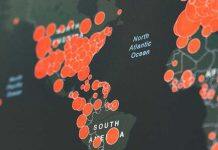Tara Ryan-DeDominicis has been an invaluable guide to our social work program, supervising student internships, providing advice on assignments and more. She is a social worker in the field of homelessness and has been doing her best to help those struggling with homelessness during the COVID-19 pandemic.


This is her story.
Morristown, N.J. (June 22, 2020) – There are currently 8,864 people in the state of New Jersey who are considered homeless. Considering the difficulties accessing this population, that number is considered a low estimate by many of us who work in this field. Persons who are homeless are already at greater risk than their non-homeless peers for significant health issues including pulmonary disease, respiratory infections, tuberculosis, and HIV. Additionally, before this pandemic, persons who are homeless experience hospitalization five times more than the general community.
These medical disparities and lack of general wellness, including lack of access to nutritious meals, insufficient sleep and inability to properly social distance, make for a very at-risk population during the time of COVID-19. Even those who are in homeless shelters during this time are unable to properly remain socially distant due to shelter overcrowding and with bunk beds, in many cases less than two feet apart. In this post I hope to share my first-hand perspective as a social worker in homeless services during the time of COVID.
I am in the field of homelessness and am often a resource to answer questions specifically about unemployment, health insurance and health care, housing assistance, etc. Although sometimes difficult, I could always find an answer. Currently, finding answers has become increasingly difficult. Myself and many social workers are facing questions we do not know how to respond to and have been introduced to a problem so large it has changed the systems we once knew how to navigate.
“All the shelters are closing their doors, where do I go?” ” I cannot get through to unemployment on the phone, what do I do now?” ” How do I socially distance myself in a tent city?”. These are but a few examples of how the homeless population is struggling with an already limited amount of resources in the face of the pandemic.
While I spend my days trying to get my guests the best and most honest answers I can to their questions, I keep glancing at the sticky note I placed on my laptop: “Physically distant. NOT emotionally distant. NOT spiritually distant. NOT compassionately distant.”
In this time of unprecedented uncertainty, I put all my efforts into what I can control for myself and for guests. I am no longer able to offer the warmth and safety of our large dining room, where guests can charge their phones, wash up in the restroom or escape the rain. I am no longer able to offer interactions between our guests and our staff and volunteers who are a source of comfort and socialization while they enjoy a hot meal.
During this time of social distancing we are able to provide bagged lunches and groceries to the line of socially distanced individuals standing six feet apart outside our door, as new restrictions prevent guests from entering our facility.
My agency was often a place where guests were able to have a hot meal, socialize, and most importantly were offered a break from the elements of living outside. This shift has been an adjustment for our guests, but also the social workers and how we work with them. We are able to provide the meals in white paper bags instead of large blue plates and we are still providing social services via text message or phone call instead of sitting side by side. Both provider and guest have acknowledged that this is not the same. However, despite not being able to be near them, it does not mean we cannot remain close to them.
I am trying to do whatever can be done to maintain connection with my population during this time of crisis – a population already facing loneliness and isolation. For me, that has ranged from FaceTiming a guest to make sure they are taking their medicine to praying the rosary with a scared guest over the phone. Showing I am still here by putting a cupcake in a guest’s lunch because she is turning 30 years old today with no one to celebrate with and using petty cash to send dog food to a guest who is unable to go to the store for her pet.
These attempts to remain connected to my guests on an individual level are in addition to efforts on a larger scale between my agency, the county and other community resources. We all have the same goal to access testing for the homeless population, locate any available shelter or motel beds and ensure anyone living outside has the supplies they need.
These times are uncertain and I cannot promise my guests as much as I would like. I am unable to provide our individual mindfulness counseling to our guests who struggle with trauma or our music therapy that so many of our guests look forward to. It takes me longer to navigate the systems that are put in place to assist this population such as benefit enrollment and direct service connection.
I am still searching, researching, and sitting with many questions I hope to be able to answer for them. What I can promise them is that I will be there, I will answer the text, I will pray with them, cry with them, and laugh with them until we are together again. I will advocate to the local government and community for their needs and spend hours on the phone adjusting our systems to allow for easier access and more complete services for all our vulnerable guests. What I can promise is in this time of social distancing, is I will still be there.
Story courtesy of the National Center for Excellence in Homeless Services.










































